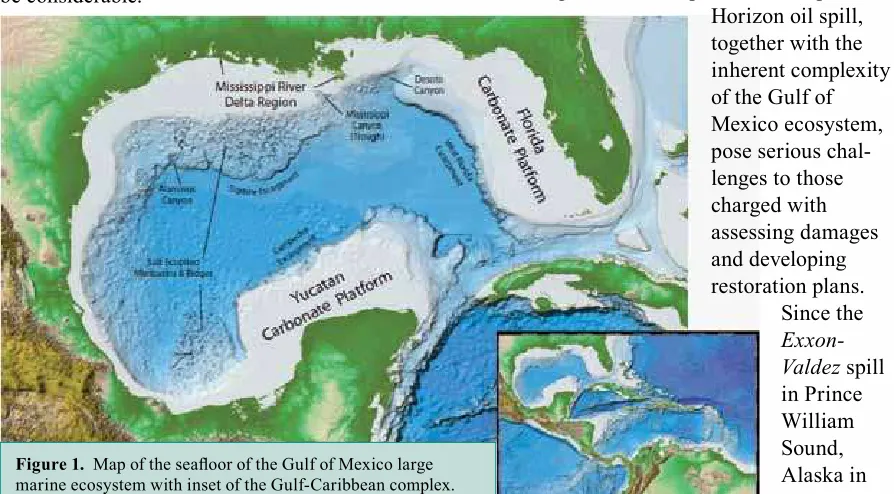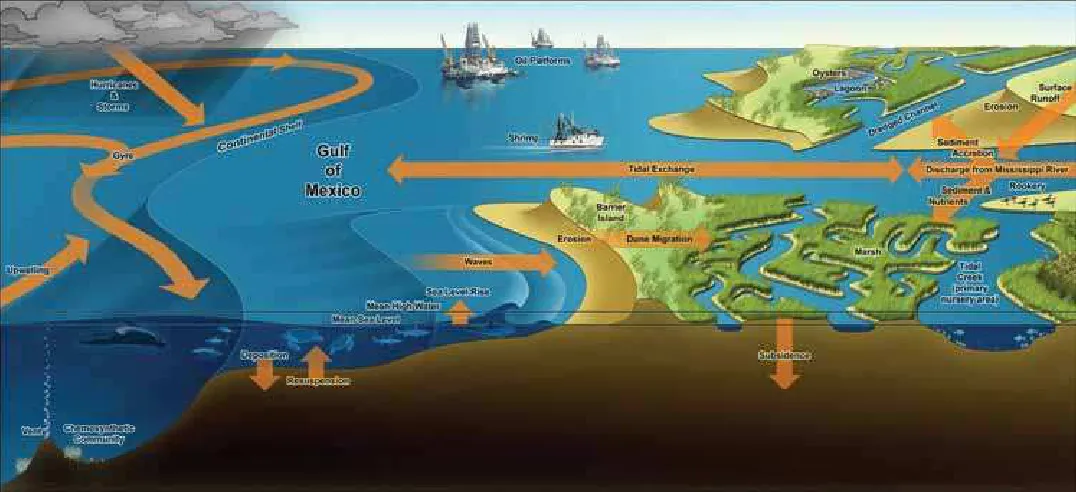Figure 1. Map of the sealoor of the Gulf of Mexico large marine ecosystem with inset of the Gulf-Caribbean complex.
Based on data from Amante, C. and B. W. Eakins (2009), image constructed using Fledermaus visualization software.
O
n April 20, 2010, the Deepwater Horizonplatform drilling the Macondo well exploded, killing 11 oil workers and injuring another 17. The oil spill that followed was unprecedented in magnitude: over a period of three months, nearly 5 million barrels (approximately 200 million gallons) of crude oil leaked into the Gulf of Mexico. To prevent consumption of seafood that might have become contaminated by oil, 80,000 square miles of the U.S. Exclusive Economic Zone were closed to ishing over the short term, resulting in the loss of food, jobs, and recreation. The full scale of the effects of the spill over the longer term could be considerable.
The parties liable for the spill have the responsibility to “make the environment and the public whole” through compensation and restoration of natural resources injured as a consequence of the spill. This requires assess-ment of the extent and severity of an injury to a natural resource through a process known as the Natural Resources Damage Assessment (NRDA). In addition to quantifying the extent of damage, the assessment includes plans for developing, implementing, and monitoring restoration and compiles expenses for both assessment and restoration costs from those deemed responsible.
The magnitude and depth of the Deepwater Horizon oil spill, together with the inherent complexity of the Gulf of Mexico ecosystem, pose serious chal-lenges to those charged with assessing damages and developing restoration plans.
Since the Exxon-Valdez spill in Prince William Sound, Alaska in 1989, most
Approaches for Ecosystem Services
Valuation for the Gulf of Mexico after the
Deepwater Horizon Oil Spill
The unprecedented magnitude of the Deepwater Horizon oil spill presents signiicant chal-lenges for oil spill responders and those tasked with assessing the impacts of the spill.
assessments have been applied to events of more limited
Approaches to Assessing and Evaluating
Ecosystem Services
The National Oceanic and Atmospheric Administra-Methods to Establish a Baseline
In order to assess the impacts of the Deepwater
An Ecosystem Services Approach to
Damage Assessment
Implementing an ecosystem approach to damage assessment requires an understanding of the complex linkages amongst various ecosystem components,
Box 1: Understanding the Gulf of Mexico Ecosystem
The Gulf of Mexico is a remarkably rich and complex
including the impact of humans on the structure and function of the ecosystem, the resulting changes in ecosystem services, and how these changes affect human well-being.
1. Determining the impact of human actions on the structure and function of the ecosystem
Scientists will need to investigate each ecosystem service by carrying out speciic types of sampling and analysis to complement the information collected under the existing damage assessment process. In order to extend the current damage assessment to include an ecosystem services approach, scientists need to under-stand how these various components have been affected by human actions, the consequences for the structure and function of the ecosystem, and ultimately the changes in ecosystem services caused by the spill.
2. Establishing how changes in the ecosystem lead to changes in ecosystem services
Once the impacts on ecosystem function and structure are identiied, the second step is to determine the
ecosystem production functions –how the ecosystem transforms inputs into outputs such as ishery landings.
For some ecosystem services, ecological production functions are fairly well understood and data exist that can help quantify the amount of a service provided. However, for many other ecosystem services, a lack of mechanistic understanding and data inhibits accurate quantiication of ecosystem services. The complexity of
marine ecosystems makes it dificult to understand how disturbances to an ecosystem will reverberate through the system and ultimately lead to changes in the provision of ecosystem services.
In general, establishing models of ecological produc-tion functions is perhaps the greatest challenge facing the application of an ecosystem services approach to damage assessment. Utilizing the extensive data that have been collected for the Natural Resource Damage Assessment process and employing the existing models for Gulf of Mexico ecosystem function presents an opportunity to enhance understanding of the provision of ecosystem services in the Gulf of Mexico.
3. Establishing how changes in the provision of ecosys-tem services affect human well-being
The third component of the ecosystem services approach focuses on establishing the values of ecosystem services. This involves combining economic methods with ecological assessments to estimate the value of changes in ecosystem services as a result of environ-mental impacts.
Valuation methods are used to provide a common, quantitative measure to facilitate comparisons among various services as an indication of how much the avail-ability of the service contributes to the improvement in human well-being. The economic approach to valuation begins with individuals and the tradeoffs they are willing to make. By measuring what an individual is willing to Figure 2. This illustration shows some of the various components and processes of the Gulf of Mexico ecosystem.
Committee on The Effects of the Deepwater Horizon Mississippi Canyon-252 Oil Spill on Ecosystem Services in the Gulf of Mexico: Larry A. Mayer (Chair), University of New Hampshire, Durham; Michel C. Boufadel, Temple University, Philadelphia, Pennsylvania; Jorge Brenner, The Nature Conservatory, Corpus Christi, Texas; Robert S. Carney, Louisiana State University, Baton Rouge; Cortis K. Cooper, Chevron Energy Technology Company, San Ramon, California; Jody W. Deming, University of Washington, Seattle; David J. Die, University of Miami, Florida;
Josh Eagle, University of South Carolina, Columbia; Joseph R. Geraci, University of Maryland. College Park;
Barbara A. Knuth, Cornell University, Ithaca, New York; Kenneth Lee, Fisheries and Oceans Canada, Dartmouth, Nova Scotia; James T. Morris, University of South Carolina, Columbia; Stephen Polasky, University of Minnesota, St. Paul; Nancy N. Rabalais, Louisiana Universities Marine Consortium, Chauvin; Christopher Reddy*, Woods Hole Oceanographic Institution, Massachusetts; Ralph G. Stahhl, Jr., DuPont Company, Wilmington, Delaware;
David W. Yoskowitz, Texas A&M University, Corpus Christi; Kim Waddell, (Study Director); Sherrie Forrest, (Associate Program Oficer); Jeremy Justice, (Senior Program Assistant, until July 2011); Lauren Harding, (Program Assistant, from July 2011); Peter Thompson, (Mirzayan Fellow, until May 2011); Christopher Prosser, (Mirzayan Fellow), National Research Council. * Resigned from the committee. The National Academies appointed the above committee of experts to address the speciic task
requested by the National Oceanographic and Atmospheric Administration. The members volunteered their time for this activity; their report is peer-reviewed and the inal product signed off by both the committee members and the National Academies. This report brief was prepared by the National Research Council based on the committee’s report.
For more information, contact the Ocean Studies Board at (202) 334-2714 or visit http://dels.nas.edu/
osb. Copies of Approaches for Ecosystem Services Valuation for the Gulf of Mexico after the Deepwater Horizon Oil Spill are available from the National Academies Press, 500 Fifth Street, NW, Washington, D.C. 20001; (800) 624-6242; www.nap.edu.
Permission granted to reproduce this brief in its entirety with no additions or alterations. Permission for images/igures must be obtained from their original source.
© 2011 The National Academy of Sciences
give up in terms of a common monetary metric, the economic approach to valuation generates measures of the relative value of goods and services. For example, how much money would people be willing to give up in exchange for restoring a coastal ecosystem? Answering this question involves identi-fying which ecosystem services would be affected by restoration and by how much. For instance, restoration might lead to improved ishing, improve-ment in water quality, and greater storm protection. Economic methods—such as revealed preference, stated preference and cost-based methods—could then be applied to assess the value of these improve-ments in ecosystem services. Alternatively, in the case of damage to the environment, valuation methods could be applied to assess how much value has been lost as a consequence of reduced ecosystem
services. Primary research on the values of ecosystem services would provide additional grounding for the Deepwater Horizon damage assessment.
Conclusion
It will take many years to fully understand the long-term effects and impacts of the Deepwater Horizon oil spill, but efforts are underway to assess the damages caused by the event and develop appro-priate restoration projects. Given the vast amount of data collected and research currently being
conducted in the Gulf of Mexico, the committee believes that efforts to apply an ecosystem services approach will result in an improved understanding of the full suite of impacts of the oil spill and lead to additional options for restoration of the ecosystem.
Read or purchase this report and locate information on related reports at

